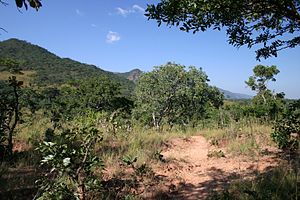- Miombo
-
 Miombo forest on the Nyika Plateau, Malawi
Miombo forest on the Nyika Plateau, Malawi
Miombo is the Swahili word for Brachystegia, a genus of tree comprising a large number of species. Miombo woodland is classified in the tropical and subtropical grasslands, savannas, and shrublands biome (in the World Wildlife Fund scheme). The biome includes four woodland savanna ecoregions (listed below) characterized by the predominant presence of Miombo species, with a range of climates from humid to semi-arid, and tropical to subtropical or even temperate.
Characteristically the trees shed their leaves for a short period in the dry season to reduce water loss, and produce a flush of new leaves just before the onset of the rainy season with rich gold and red colours masking the underlying chlorophyll, reminiscent of temperate autumn colours.
The name miombo is used in a number of Bantu languages in the region such as Shona and Bemba. In Bemba, the word "miombo" is the plural of the word "muombo", which is the specific name for the species Brachystegia longifolia.
Contents
Miombo woodland ecoregions
Miombo woodlands form a broad belt across south-central Africa, running from Angola in the west to Tanzania to the east. These woodlands are dominated by trees of subfamily Caesalpinioideae, particularly Miombo (Brachystegia), Julbernardia and Isoberlinia, which are rarely found outside Miombo woodlands. The four ecoregions are:
- Angolan Miombo woodlands (Angola)
- Central Zambezian Miombo woodlands (Angola, Burundi, Democratic Republic of the Congo, Malawi, Tanzania, Zambia)
- Eastern Miombo woodlands (Mozambique, Tanzania)
- Southern Miombo woodlands (Malawi, Mozambique, southern Zambia, Zimbabwe)
People
These miombo woodlands are also important to the livelihoods of many rural people, who depend on the resources available from the woodland. The wide variety of species provides non-timber products such as fruits, honey, fodder for livestock and fuelwood.
Flora and fauna
Despite the relatively nutrient-poor soil, long dry season (and low rainfall in some areas) the woodland is home to many species, including several miombo specialist endemic bird species. The predominant tree is miombo (Brachystegia spp.). It also provides food and cover for mammals such as the African Elephant (Loxodonta africana), African Wild Dog (Lycaon pictus), Sable Antelope (Hippotragus niger) and Lichtenstein's Hartebeest (Sigmoceros lichtensteinii).[1]
Gallery
-
Foliage and pods of the Mfuti, Brachystegia boehmii
-
Foliage and pods of the Mountain Mfuti, Brachystegia glaucescens
Line notes
- ^ Bruce M Campbell. 1996
References
- Bruce M Campbell. ed. 1996. The Miombo Transition: Woodlands & Welfare in Africa, CIFOR, ISBN 9798764072, standard reference on the description & uses to which animals and man put these savanna woodlands.
External links
Categories:- Afrotropic
- Tropical and subtropical grasslands, savannas, and shrublands
- Swahili words and phrases
Wikimedia Foundation. 2010.


